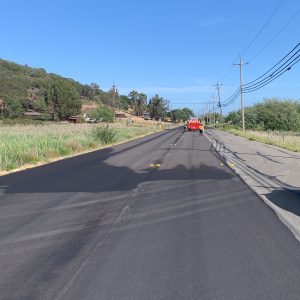For Immediate Release –
San Rafael, CA –
Funding allocations for the infrastructure program guided by various components

The 422 miles of roads maintained by the County of Marin are critical infrastructure that people rely on every day to conduct their business, connect with surrounding communities, visit popular attractions, explore Marin’s beauty, and live their daily lives.
Improvements and ongoing maintenance of the road network is a major responsibility for the Marin County Department of Public Works (DPW), and a commitment that requires significant planning and funding to undertake. At the Marin County Board of Supervisors session on June 21, DPW staff presented a proposed two-year budget for the County Road and Bridge Program, as well as defined the condition of the road network and an approach for future pavement improvements.
The County’s Road and Bridge Program budget comes from three sources, which for fiscal year 2022-23 is expected to total $16.1 million: $8 million from the County’s General Fund, $3.1 million in regional Measures AA, A and B tax revenues, and $5 million from California Senate Bill 1. The 2023-24 budget is expected to total $15 million, since Measure B allocations only occur every three years.
The Road and Bridge Program budget covers many types of projects including road improvements and stabilization, retaining walls, bridges, drainage improvements and safety updates. The largest portion of the budget is allocated specifically to the roads program, totaling $11.5 million for fiscal year 2022-23 and $10.2 million for fiscal year 2023-24.
In terms of making road improvements, projects become exponentially more expensive as the condition of the road deteriorates. A good road generally only requires preventative maintenance to keep it in good standing, whereas a road with failing pavement needs full reconstruction, which is costly and time-consuming. There are also intermediate treatments with costs ranging between those two extremes. The condition of the soil underneath the asphalt is often the determining factor for choosing the appropriate method of repair along the spectrum of intermediate treatments.
For example, $1 million may fund preventative maintenance for 15 miles of good roadway versus the same $1 million only funding reconstruction for 1 mile of failed roadway. In other terms, maintaining a good road will cost an average of $3.70 per square yard, compared to a failed road costing an average of $60 per square yard to bring into good standing.
A critical component of the pavement management program is having accurate pavement condition data and the ability to analyze scenarios for projects with different variables such as the combination of roads selected and the needed pavement treatment types. The pavement condition index (PCI) is a standardized measure of roadway quality which provides an integer value of each road segment on a 100-point scale, with 100 being a newly paved road. The raw score is determined by independent engineering consultants and standardized by the Metropolitan Transportation Commission’s Pavement Management Technical Assistance Program.
The average of all County-maintained road segments represents the overall road network PCI. For Marin County, there are 1,029 pavement segments resulting in a road network PCI of 66. California also has a PCI of 66, and the nine Bay Area counties have an average PCI of 67.
In addition to PCI, the road program considers many parameters including, but not limited to, economy of scale, cost of design challenges, road usage for all user groups, opportunities to coordinate with utility companies, candidates for grant funding, projects that can be combined with other necessary improvements, roads at risk of imminently becoming impassible, and roads where pavement is failing and they are heavily used bike routes or emergency response routes.
The long-term cost of maintenance is considered during road project selection, too. Roads with failing pavement may receive patch repairs or interim condition improvements with the intention of reducing ongoing patch repair costs once the road reaches the rapid deterioration phase of its lifecycle. Bringing them into better condition in the interim allows for the possibility of doing reconstruction later at a lower unit cost. However, the interim condition improvements strategy is only pursued under specific conditions, such as the pavement having some remaining structural strength and the underlying soil condition being within a necessary range.
“Many public agencies across America are seeing that the short-term repair strategy of ‘worst-first,’ which was used nationwide for decades, eventually results in an overall worse road network condition and increased deferred maintenance costs year over year,” said DPW Director Rosemarie Gaglione. “Ultimately the County road program is a hybrid strategy of pavement preservation, pavement rehabilitation and road reconstruction. With that approach, we plan to make significant improvements in the coming years to our road network.”
Contact:
Rosemarie Gaglione
Director
Public Works
3501 Civic Center Drive.
#304
San Rafael, CA 94903
